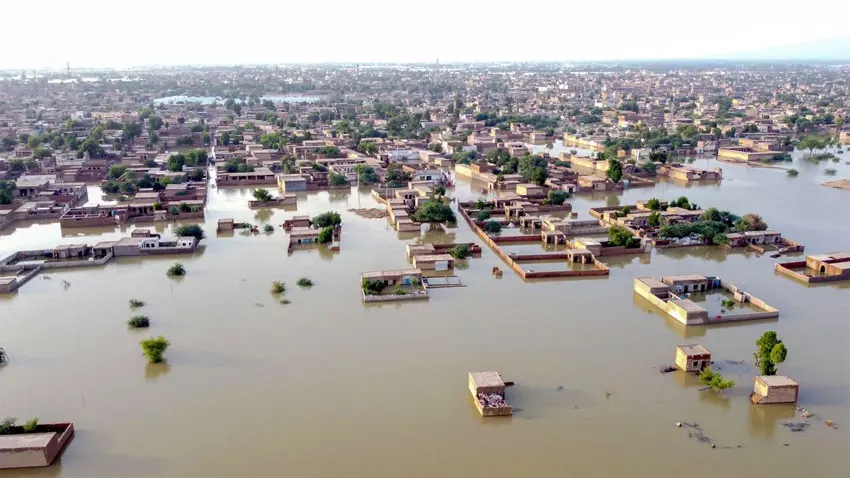Pakistan’s Punjab province is facing a catastrophic flood crisis, forcing widespread evacuations and disrupting daily life. Heavy monsoon rains, coupled with swollen rivers and dam releases, have inundated vast areas, displacing hundreds of thousands. The humanitarian impact is immense, with local authorities and international aid agencies racing to provide relief. This disaster underscores both the immediate risks of extreme weather and the long-term challenges posed by climate change.
Causes of the Floods
Monsoon Rains and Rising Water Levels
Punjab has been hit by unusually heavy monsoon rains this year, surpassing historical averages by nearly 50%. Rivers such as the Ravi, Sutlej, and Chenab have swollen beyond their capacities, overflowing into agricultural and residential areas. Low-lying villages and towns have been submerged, forcing residents to leave their homes under emergency evacuation orders.
Dam Water Releases
Water releases from upstream dams, particularly in India, have compounded the problem. While intended to manage reservoir levels, these releases have accelerated flooding downstream in Pakistan, particularly in Punjab’s districts like Kasur, Bahawalnagar, and Vehari. Local authorities have expressed concern that these releases, combined with monsoon runoff, have created an “unmanageable flood situation.”
Humanitarian Impact
Displacement and Casualties
Over 210,000 people have been evacuated so far, with the number likely to rise. The National Disaster Management Authority (NDMA) reports more than 800 deaths, with thousands injured and tens of thousands of homes damaged. Entire villages remain under water, and residents are struggling to access basic necessities.
Challenges for Residents
Flood victims face numerous challenges. Many families are reluctant to leave homes due to fear of losing livestock or personal property. Relief camps have been set up, but the scale of displacement exceeds the capacity of these shelters. Access to clean water, food, and medical supplies remains a critical concern.
Government and Military Response
Deployment of Forces
The Pakistan Army has been mobilized to assist with rescue operations, particularly in heavily affected districts. Helicopters and boats have been dispatched to reach stranded residents, and emergency evacuation centers have been established in safer areas.
Relief Efforts

Over 300 relief camps are operational, providing temporary shelter, food, and medical care. The government has called for volunteers and donations, emphasizing the need for community support. International organizations have also offered assistance, highlighting the severity of the crisis.
Economic Consequences
Agriculture and Infrastructure
Punjab, Pakistan’s agricultural heartland, is facing severe crop losses due to flooding. Thousands of acres of farmland are submerged, threatening local food security and future economic stability. Infrastructure, including roads, bridges, and electricity networks, has suffered extensive damage, further complicating relief efforts.
Estimated Economic Losses
Previous flood events in Pakistan have caused losses exceeding USD 30 billion. Although current assessments are ongoing, preliminary estimates suggest that this disaster may rival or exceed previous events in terms of economic impact.
Climate Change Implications
Experts have linked the increasing intensity and frequency of floods in Pakistan to climate change. Rising global temperatures lead to heavier rainfall events, more unpredictable monsoon patterns, and faster glacial melt in the Himalayas. Punjab’s vulnerability is exacerbated by poor urban planning and inadequate flood management infrastructure.
Regional and International Dynamics
The release of water from upstream dams has also heightened tensions between India and Pakistan. Although both countries have established flood warning protocols, the scale and timing of dam releases have led to diplomatic friction. Coordinated cross-border water management and timely alerts are critical to reducing future disaster impacts.
FAQs
How many people have been evacuated from Punjab due to the floods?
Over 210,000 individuals have been evacuated from flood-affected districts.
Which rivers have caused the flooding?
The Ravi, Sutlej, and Chenab rivers have overflowed, leading to widespread inundation.
What steps has the government taken?
The Pakistan Army has been deployed for rescue operations, and over 300 relief camps have been set up to provide shelter, food, and medical assistance.
How has climate change affected the floods?
Experts link heavier monsoon rains and unpredictable river behavior to climate change, increasing the severity of flooding events.
What is the economic impact of the floods?
Crop losses, damaged infrastructure, and disrupted local economies could result in losses exceeding billions of dollars, with long-term implications for food security and livelihoods.
Conclusion
The flood crisis in Punjab is a stark reminder of the devastating intersection between extreme weather, climate change, and inadequate preparedness. Immediate relief efforts are critical to save lives and stabilize affected communities. However, long-term strategies—including improved flood infrastructure, early warning systems, and regional cooperation—are essential to prevent future catastrophes. The resilience of Punjab’s residents, combined with government and international support, will determine how quickly the province recovers from this disaster.











